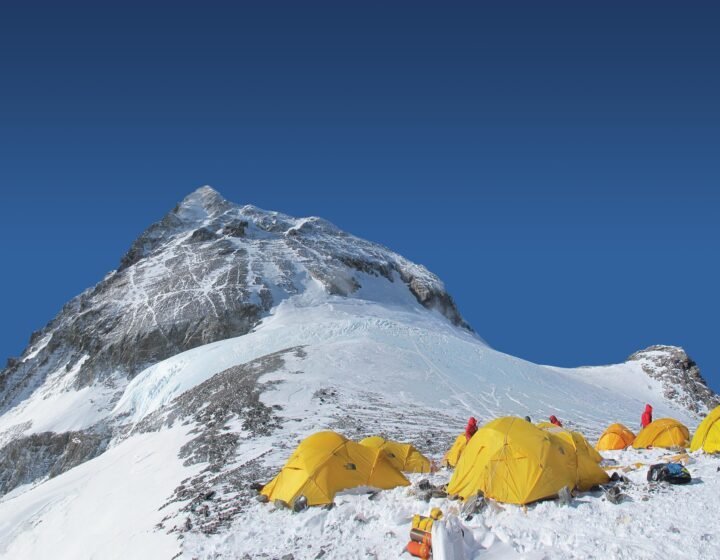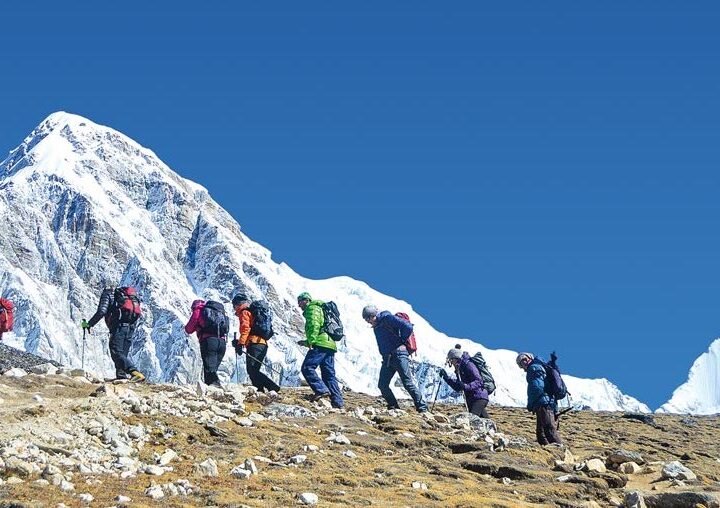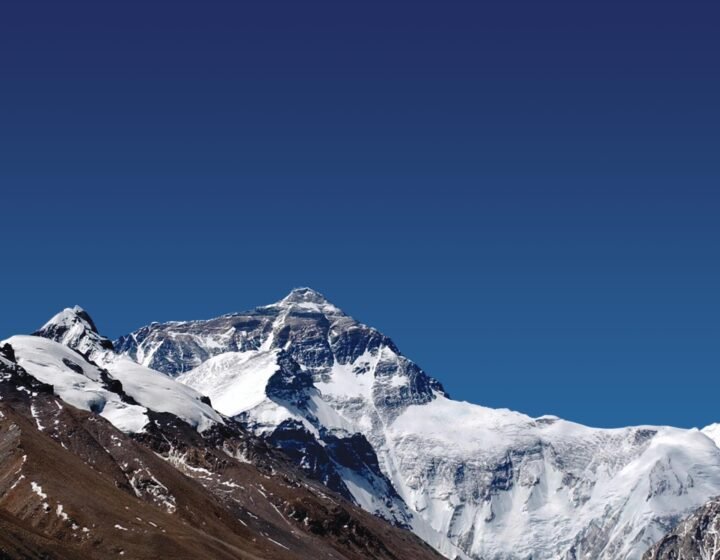- Details
Detailed itinerary
Itinerary- Tour Includes/Excludes
- Useful Info
- Trip Map
- FAQ
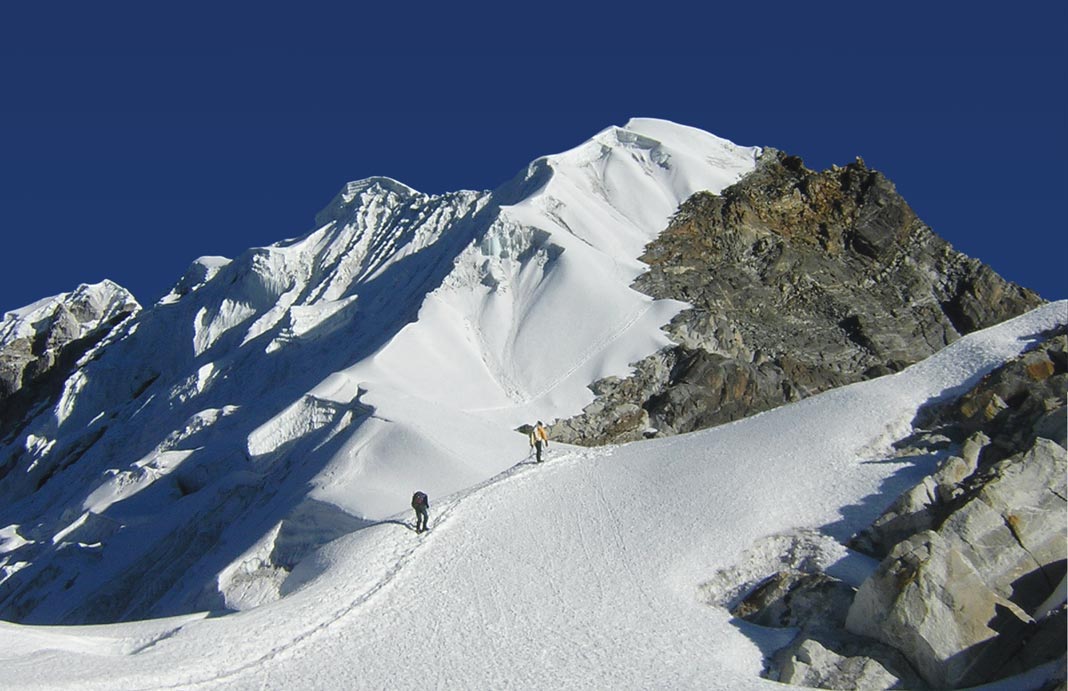
Trip overview
Mt. Kanchenjunga (8,585 m) is the world’s third tallest peak. Kanchenjunga is derived from the Tibetan phrase which means “five wonderful treasures in the snow” and Its five summits are represented by gold, silver, valuable stones, grain, and holy books. Among the five the most popular summit is Kanchenjunga West, also known as Yalung Kang (8,505m). There are roughly twenty peaks above 7,000 meters in this area, the tallest being Kambachen (7,903m), Janu (7,710m), Jongsong (7,483m), Kabru (7,353m), Tent Peak (7,365m), and the Twins (7,350m).
Kanchenjunga is located in Nepal’s far east and is protected by the Kanchenjunga Conservation Area Project. Several species can be found in the protection area, including pheasants, dragons, snow leopards, black bears, and red pandas. If you are someone seeking peace in nature, this route will be perfect for you. Kanchenjunga region was originally a banned territory and isolated from trekkers but only in 1988, it was accessible to the trekkers. The Kanchenjunga region trip passes through small Sherpa towns, dense rhododendron woodland, green rolling hills, terraced fields, and a parched environment on its way from the lower region to the upper heights.
The journey includes a flight from Biratnagar to Suketar with views of the Kanchenjunga range. Unlike the EBC and ABC treks, the Kanchenjunga trek follows a more rustic and lengthier trail, making it relatively tough and requiring extra physical fitness. It could be one of the reasons why few people prefer to trek in this area.
Likewise trekking in this region is not possible without a licensed guide because most of the places are off-limits to visitors. As additional information, all the trekkers must ensure that they have a permit and traveling groups with whom they will trek to Kanchanjunga.
Best season for Kanchenjunga
Every season is ideal for trekking in this region. Thought spring and autumn are taken as the best trekking seasons to experience the clear sky and fresh environment. If you enjoy peace and quiet then Kanchenjunga region hike is the ideal package for you.
Highlights:
- Tibetan hospitality
- Traditional Nepali culture
- Remoteness and untouched natural heritage
- Mt Kanchenjunga-the world’s third highest peak
- wildlife such as snow leopards, musk deer, and red pandas. Different landscapes, from forests to meadows.
- Snow-capped mountains above 8000m
- Kanchenjunga glacier and many others.
- Rivers and waterfalls
Itinerary
Day 1: Arrival in Kathmandu / Hotel stayWhen you arrive in Kathmandu, the trek begins. Our agent will meet you at Tribhuvan International Airport and transport you to your hotel. Enjoy a drink and a warm dinner at the hotel. We'll serve you delicious Nepali cuisine in the evening. In the meantime, take a stroll through Thamel Town in Kathmandu.
On the second day, first go to Pashupatinath Temple, a very famous Hindu temple in the world, and then to Boudhanath Stupa, the largest Buddhist Stupa in the world.
There will be a trek briefing and trek pack in the afternoon. Our trek agent will give you a briefing and distribute the trekking gear supplied by us.
The flight from Kathmandu to Bhadrapur takes nearly 45 minutes and provides breathtaking views of the entire Kanchenjunga trek. The 359-kilometer drive from Bhadrapur to Taplejung is interesting, taking us through various hillsides, villages, and tea gardens with spectacular views and eye-catching landscapes to the District Head Quarters-Telejung. We are staying at the Taplejung Hotel. (8–9 hrs). Following that, we trekked for three days in the Tamur River Valley, beginning at 921m and ending at 1650m in Sekathum. We'll be walking along the river and through the rainforest, surrounded by abundant birdlife. The valley is breathtaking, with a deep tarmac gorge filled with magnificent cliffs, waterfalls, and the gosling sound of glacial water flow.
Our journey takes us through the Tamur River Valley and then into the Ghunsa River Valley. We cross Simbuwa Khola, which flows from the Yalung glacier just before Sekathum.
The narrow trail follows the Ghunsa River Valley before beginning to climb towards Amjilosha. As we ascend higher in elevation, we pass through traditional Sherpa and Tibetan settlements.
There are some easy days walking through the dense forest in the remote area.
As we approach 3,000 meters in elevation, we maintain a slow and comfortable pace to avoid Acute Mountain Sickness.
When we walk from Gyabla to Ghunsa, we arrive in Phole, a traditional Tibetan village, after a long climb through a dense forest of pine, fir, and rhododendron trees. We take a break here, eat lunch, and visit an old Buddhist monastery in the village.
We arrived in Ghunsa village (3,400 m) after a 6-day hike, which is the last permanent settlement on the way to North Kanchanjunga Base Camp.
From Ghunsa, we will explore Kanchenjunga North Base Camp. It is a magnificent glacial valley. You can walk through the moraine with a breathtaking view of the Kanchenjunga massif.
There are no villages or houses in this remote high-altitude glacial terrain. Because our trail gradually ascends through moraine debris, we have a good chance of seeing wildlife such as blue sheep, mountain goats, or smaller animals such as pikka, marmots, and birds of prey such as falcons, kites, and eagles.
The trail begins on the north side of the glacier at Ramtangat (4,240 m) and continues on its south side to Lhonak, which is located at the junction of the Lhonak and Kanchenjunga glaciers and surrounded by breathtaking mountains in all directions.
Eventually, we will explore Kanchenjunga's north base camp, also known as Pang Pema, and we will explore the glacier as much as possible while admiring the magnificent Kanchenjunga and other snow-peaked mountains.
After exploring Kanchenjunga North Base Camp, we return to Ghunsa and prepare to hike up to Selele Base Camp and cross all three passes.
We begin our ascent from Ghunsa, following the locals' trail through a dense forest of birch, pine, and rhododendron.
We spent the night at the Selele base camp, also known as Selele Kharka. We are staying in a basic lodge for one night.
Today's trek will be difficult, with a steep 400-meter climb to Mirgin La Pass, which offers spectacular views of Jannu Himal, Makalu, Baruntse, Chamlang, Kanchenjunga, Kyabru, and the Himalayan range, as well as the Sikkim border.
We continue along the ridges before making the final descent to Tseram. We spend the night at Tseram, 4,730 m, in a tea house.
Today we leave early in the morning from Ramche to hike 7 kilometers to Oktang (4,730 m) and enjoy the breathtaking views of Kanchenjunga Himal. Kanchenjunga has five distinct peaks, which are also known as the "5 Jewels of Kanchenjunga." Other impressive peaks on the Nepal-Sikkim border include Rothang and Kyabru, which are all breathtaking. We return to Ramche and walk down to Tserum, where we spend the night after admiring the beauty of Kanchenjunga Himal, Yalung glacier, and all the other beautiful peaks and hills.
We follow an easy trail alongside Simbua Khola, descending through pine and rhododendron forest all the way to Yamphuding.
This is a difficult section of the trek because of the landslides and the 600-meter climb to the Lamite pass.
We walk through the lovely villages of Chhetri and Brahmins, crossing two passes.
On the final day, we hike around 1200 m up to Tharpu Village and enjoy the last glimpses of the Kanchenjunga Himalayan range with a sunset view from the village before wrapping up this wonderful trek here.
You'll enjoy driving through the various scenic landscapes and picturesque valleys on your way to Bhadrapur.
While flying to Kathmandu, you will be treated to a breathtaking view of the Himalayan ranges. After you arrive in Kathmandu, you have the afternoon free to explore Thamel, a popular tourist destination in Kathmandu, and do any last-minute shopping.
A private vehicle will transport you to the airport after breakfast at the hotel. Your trek leader will be there to help you, and you will return home with fond memories of the mountains, people, and places.
Included
- Private domestic and international flight arrival and departure transfers
- Standard hotel accommodations in Kathmandu on a bed-and-breakfast basis in accordance with the program.
- The welcome meal is included in the Kanchenjunga Circuit trek program.
- A half-day guided city tour with entrance fees to world heritage sites as specified in the program.
- All domestic flights and airport charges as specified in the Kanchenjunga trek schedule.
- Private transportation to and from the trek's beginning and ending places, if applicable.
- Full board meals, tea, coffee, and drinking water provided by the tea house cook throughout the journey
- Accommodation in a local tea house while walking to Kanchenjunga
- Trip Gear from our agency - sleeping bag, fleece liner, down jacket, rain poncho, and other items for usage on a trip.
- Professional and experienced Trek Leader / Guide with Wilderness First Aid training.
- Supplementary Oxygen or Gamow Bag (A life-saving equipment in the event of Acute Mountain Sickness) as a trek safety backup, in addition to the comprehensive First Aid Kit
- Professional and experienced Trek Leader / Guide educated in Wilderness First Aid, as well as his trek crew comprising porters, with necessary insurance and trek equipment.
- Additional trip Duffle bag T-shirts and a journey map from our company
- A special trekking permit to Kanchenjunga, as well as any government taxes.
- TIMS / Trekking permit, National Park / Conservation costs
Not Included
- Nepal entry visa fees, any travel insurance, international airfare, and airport taxes
- All beverages and main meals in cities
- Tips and personal costs such as a hot shower, battery charge, phone, and beverage drinks
Useful Info
- All foreign travelers must give their personal (visa and passport) information when booking and arriving.
- Expect all trekkers to carry no non-biodegradable items.
- Intoxicating substances and alcohol usage are strictly prohibited when trekking.
- It is recommended to have a buffer day to deal with an unexpected incident.
- It is also recommended to carry cash, incase ATMs are not available.
- All tourists must maintain their passports or visa with travel agencies.
- Dehydration is more likely at higher altitudes, so drink plenty of water and bring extra bottles with you.
- Layering clothes is the best approach to maintaining your body temperature while trekking at higher altitudes, thus zippered wears are the best alternative.
- Because mobile phone and camera batteries are prone to going dead or losing power quickly, a portable charger is an absolute necessity for your electronic devices.
Trip Map
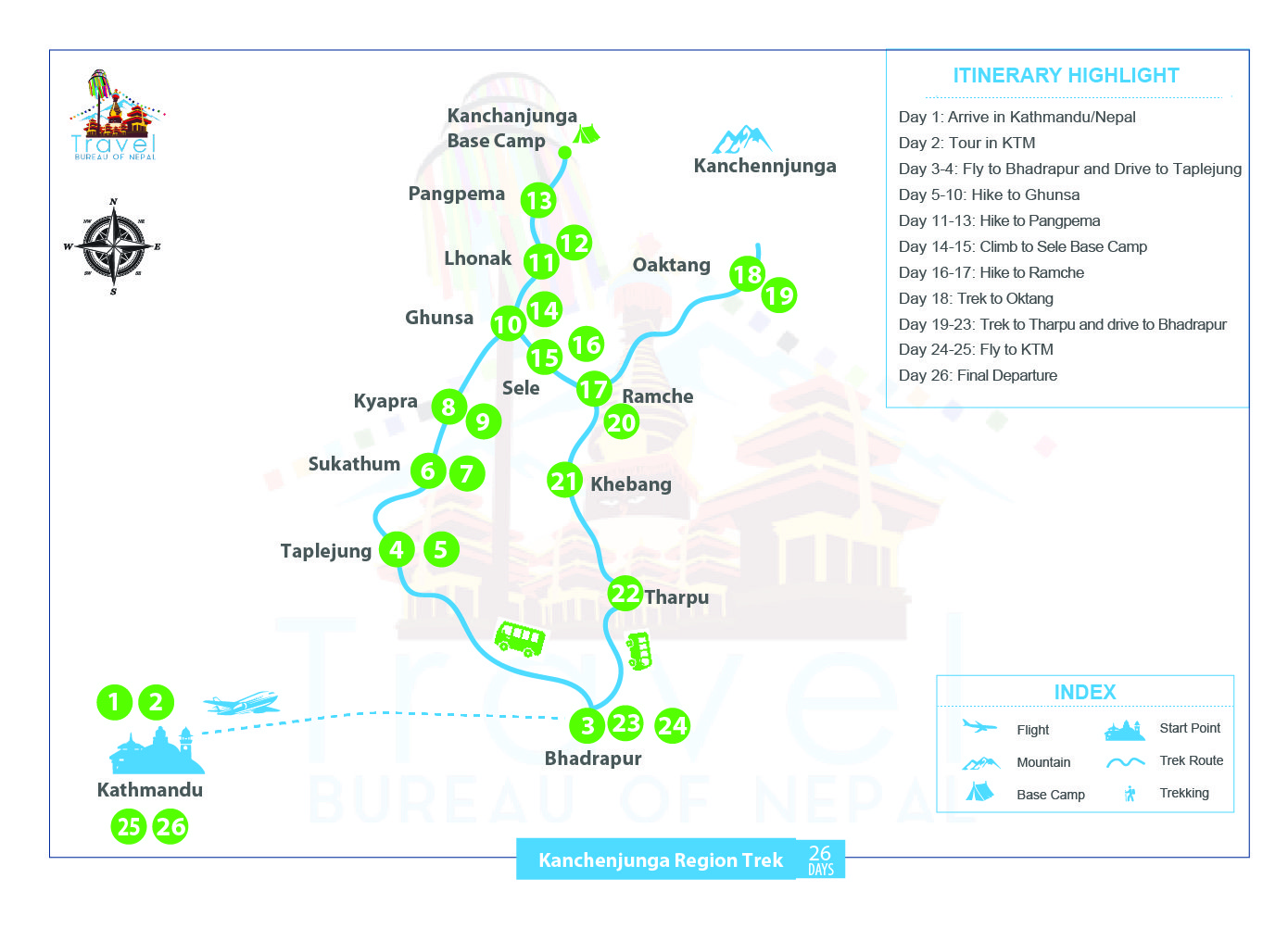
FAQs
-
Is travel insurance required for the Kanchenjunga Trek?
All hikers should ensure they have enough travel insurance. The most dangerous hazards for trekkers in the Kanchenjunga region are high altitude illness and diarrhea.
-
Is travel insurance required for the Kanchenjunga Trek?
All hikers should ensure they have enough travel insurance. The most dangerous hazards for trekkers in the Kanchenjunga region are high altitude illness and diarrhea.
-
When is the ideal time to climb Mount Kanchenjunga?
March through May and September to late November are the best months for a Kanchenjunga trip.
-
What is the temperature at night?
The temperature can dip to -10 C / 14 F at night. During the day, it will be mostly sunny. Depending on the month, the temperature may vary. We recommend that you do not rely on weather forecasts. It is still in its infancy.
-
Is Kanchenjunga tough to climb?
Kanchenjunga is the most difficult and time-consuming of the 8000ers to reach the summit from the last camp. Climbers begin their ascent from Camp IV around 21.00-22.00 pm towards Mt. Kanchenjunga, the highest peak in the 8000m range at 1036m.

